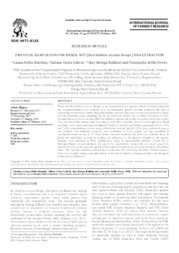Protocol adaptation for brazil nut (Bertholletia excelsa Bonpl) DNA extraction.
Protocol adaptation for brazil nut (Bertholletia excelsa Bonpl) DNA extraction.
Author(s): GIUSTINA, L. D.; CABRAL, J. C.; BALDONI, A. B.; NEVES, L. G.
Summary: Brazil nut (Bertholletia excelsa Bonpl.) is an Amazonian Forest species, which is acknowledged for the commercialization of its almonds. It is an endangered species, fact that reinforces the need of conducting conservation studies. Molecular markers are tools that may be used in conservation studies and the primordial stage preceding the use of molecular markers lies on DNA extraction. A well-designed protocol allows isolating DNA in sufficient amount and quality to conduct molecular studies. Thus, the aim of the current study is to adapt a total DNA extraction protocol to be applied to Brazil nut plants. Tests were conducted at different CTAB (2% and 4%) and β-Mercaptoethanol (0.2%, 0.8% and 1.4%) concentrations; washes using chloroform: isoamyl alcohol (CIA) were performed (one or two washes). The extraction products were confirmed in 0.8% agarose gel and quantified in spectrophotometer (in ng μL-1). Plant tissue (vascular cambium and leaf) was collected from 30 Brazil nut individuals in order to confirm the efficiency of the protocol adapted to the species. Samples were subjected to PCR amplification using 10 microsatellite markers. CTAB and β-Mercaptoethanol at concentrations 4% and 0.2%, respectively, along with one wash using CIA, showed the best results when the quality of the extracted material was assessed through its absorbance ratios. The vascular cambium oxidized more easily than the leaf during the DNA isolation process. Thus, it is essential taking some precautions at the time to handle it during collection and storage to assure process efficiency.
Publication year: 2018
Types of publication: Journal article
Observation
Some of Embrapa's publications are published as ePub files. To read them, use or download one of the following free software options to your computer or mobile device. Android: Google Play Books; IOS: iBooks; Windows and Linux: Calibre.
Access other publications
Access the Agricultural Research Database (BDPA) to consult Embrapa's full library collection and records.
Visit Embrapa Bookstore to purchase books and other publications sold by Embrapa.

